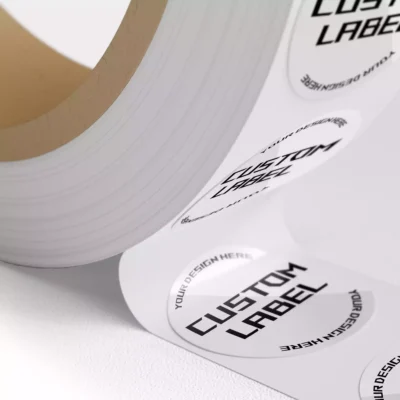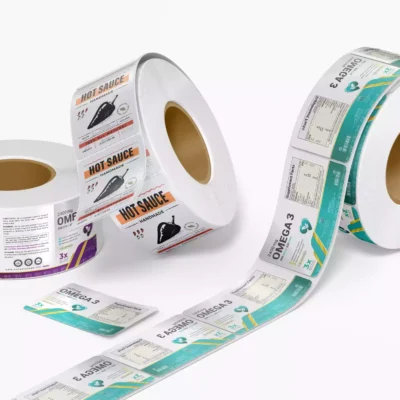Stickers and decals are similar items often used for marketing, advertising, and decorating. Many people use the terms ‘sticker’ and ‘decal’ interchangeably. However, there are some important differences.
What is a Sticker?
Stickers are some of the most common adhesive graphics we encounter daily. From bumper stickers that express political opinions to cute labels on your favorite coffee shop’s packaging, to laptop and waterbottle stickers. They come in all shapes and sizes. The primary characteristic of a sticker is its adhesive backing, which allows it to stick to various surfaces.
Stickers can be made from various materials, including paper, vinyl, and even cloth. This versatility makes them a popular choice for both personal and commercial use.
Paper stickers are typical for labels and temporary decorations due to their ease of printing and affordability. However, they are not as durable as their vinyl counterparts and are susceptible to water and UV light damage.
On the other hand, vinyl stickers offer a durable solution that can withstand outdoor elements, making them ideal for cars, water bottles, luggage, or anything that might encounter weather or wear and tear.
Despite their durability, stickers, in general, are considered to be more temporary and are easier to remove compared to decals, making them ideal for promotional materials or personalizing items that may change frequently.
What is a Decal?
Decals are a specialized subset of stickers designed for longer-term applications and are usually made from vinyl. Vinyl is key to their durability and suitability for outdoor use, since it is waterproof and resistant to fading from sunlight.
Decals are typically cut to the shape of lettering or branding. Think storefront windows, or wall art.
Applying a decal is slightly more complex than sticking a sticker. Decals typically come with transfer tape that helps apply the cut-out design cleanly and precisely without bubbles or wrinkles, which is particularly important for large or intricate designs.
The durability of vinyl decals makes them a favorite for businesses and individuals looking for a long-lasting option. For example, car decals can last for years, even in harsh weather conditions, making them a popular choice for business branding on company vehicles. Similarly, wall decals can transform a room without the commitment or expense of wallpaper.
The simplicity and clarity of images or letters cut from vinyl allow for intricate designs ranging from elegant script for storefront signage to detailed graphics for personal devices.
Differences Between Stickers and Decals
The distinction between stickers and decals goes beyond their material composition and durability. One of the most significant differences lies in their intended use and application process.
Stickers, with their wide variety of materials, are super versatile. They can serve as everything from simple name tags to complex, multi-colored designs for product branding. Their ease of use makes them accessible to everyone, from kids looking to decorate their school supplies to professionals creating promotional materials.
Decals, by contrast, are specifically designed for more permanent applications and often require a more careful application process. While more involved, this process results in a clean, professional appearance – ideal for business branding or high-quality personalization.
Finally, the removability of stickers versus decals is another difference; stickers can usually be peeled off without much residue, while decals, might leave adhesive behind or even damage the surface upon removal.
Choosing the Right Option for Your Needs
When deciding whether to use a sticker or a decal, consider the application’s purpose, surface, longevity, and aesthetic requirements. Stickers are your best bet if you’re looking for a temporary way to add personality to personal items or create short-term promotional materials. They’re affordable, easy to distribute, and easily replaced or removed.
On the other hand, decals are the way to go if you’re seeking a more durable solution for outdoor use or want a sleek, professional look for business branding.
It’s also important to consider the surface you’ll be applying your sticker or decal. Rough or porous surfaces might not adhere well to stickers. In contrast, decals, especially vinyl ones, can adhere more securely to various surfaces, including glass, plastic, metal, and more.
Budget is another consideration; stickers are typically quite affordable, especially in bulk. Decals have a more manual production process, which means the cost is typically higher than that of stickers.
Final Thoughts
Both stickers and decals offer unique advantages depending on your specific needs. By understanding the differences between these two options, you can make an informed decision that aligns with your goals, whether for personal expression or professional branding.
Remember, the best choice is the one that best suits your project’s requirements, considering factors like durability, application surface, budget, and design complexity. Whether you choose a sticker or a decal, each has the potential to add a splash of color, a touch of personality, or a professional sheen to your chosen surface, making your message stick in the minds of your audience.




